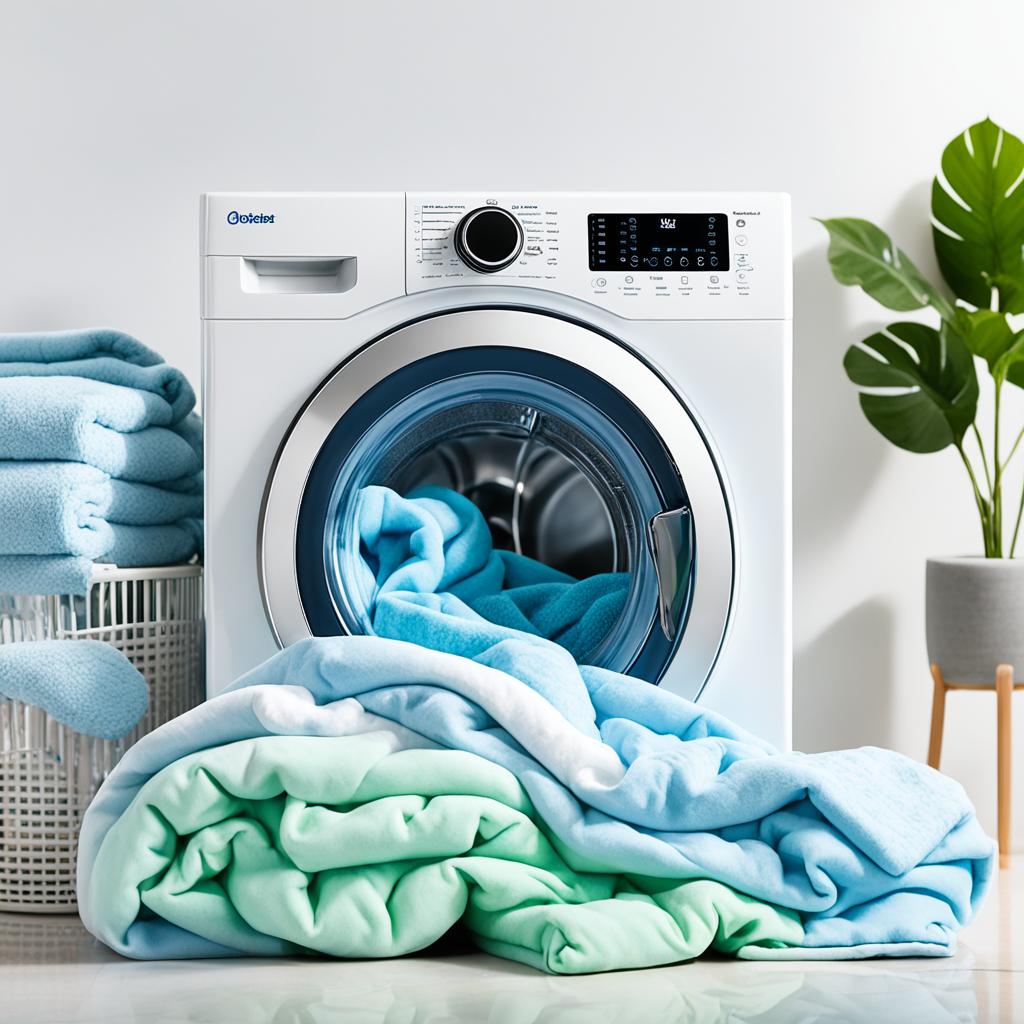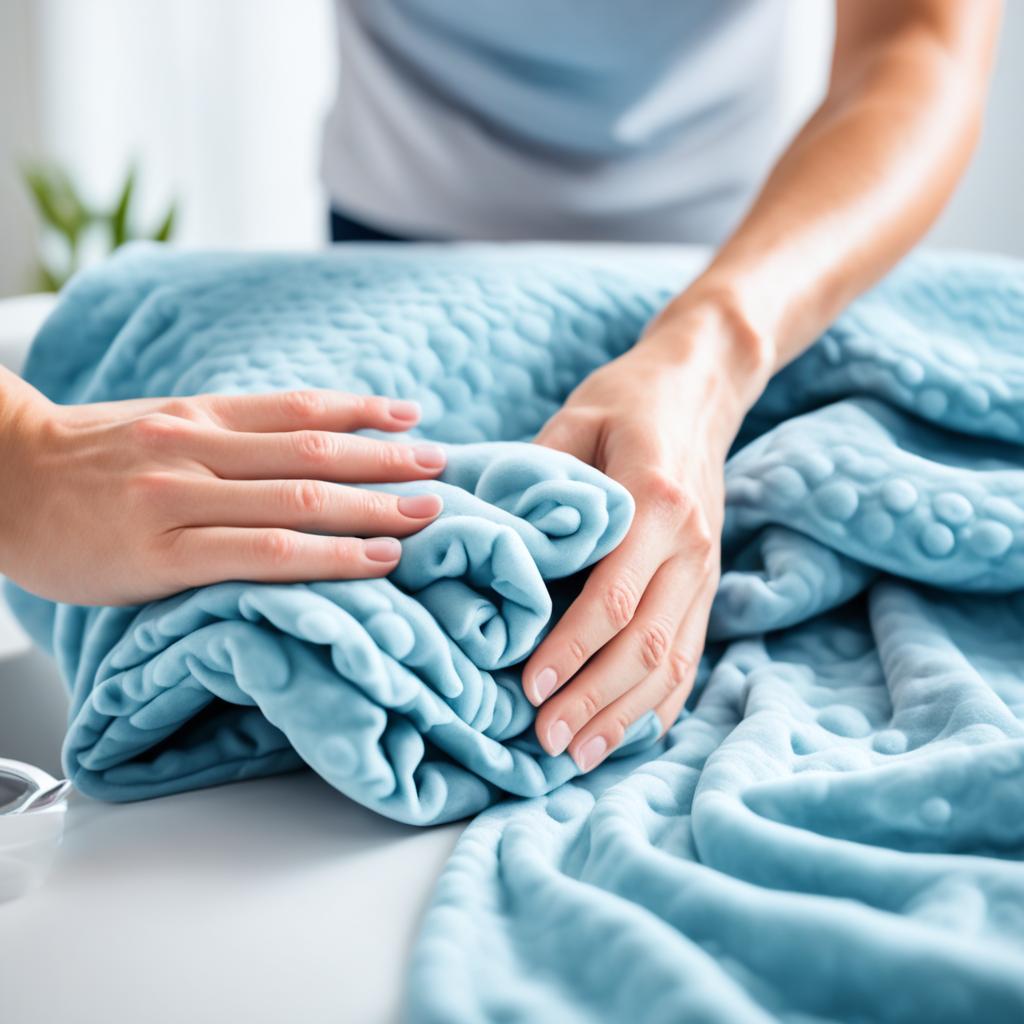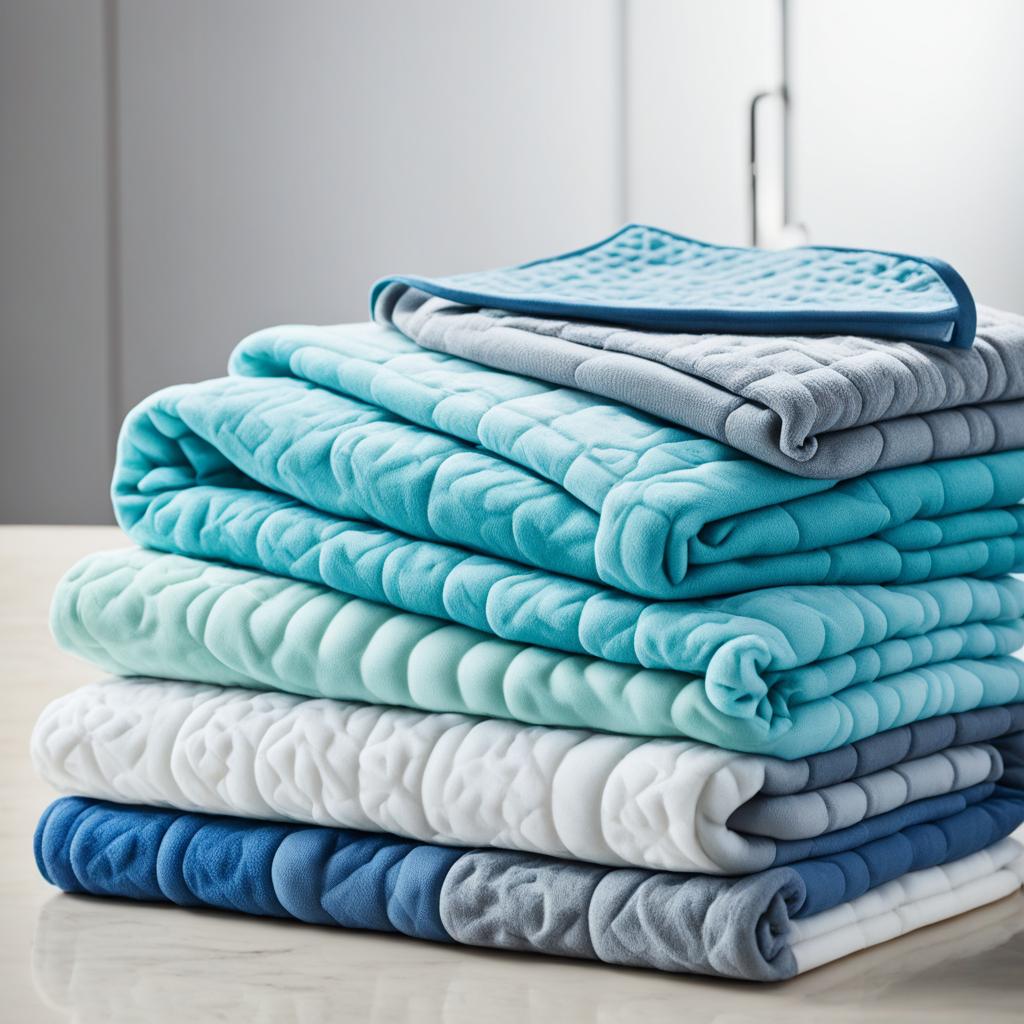Weighted blankets are now a common sleep aid, helping those with insomnia, anxiety, and restlessness. They need proper care to stay fresh and effective. Let’s explore how to keep your sleep space clean and welcoming.
Cleaning these blankets is key to keeping their benefits. They can be as heavy as 30 pounds, making laundry a challenge. Knowing how to wash them right is important, whether they’re made of cotton, polyester, or a mix.
If you use your weighted blanket every night, wash it every few weeks to fight sweat and oil. If you use it less often, a few cleanings a year are enough. Always check the care label before washing, as some can be machine washed, while others need hand washing or professional cleaning.
Proper care can make your weighted blanket last longer than five years. Let’s look at how to keep it in great shape, from spot cleaning to full washes. This way, you’ll enjoy your blanket for a long time.
Key Takeaways
- Wash weighted blankets every few weeks if used nightly, or 3-4 times a year for occasional use
- Always check the care label before washing
- Some weighted blankets are machine-washable, while others require hand washing
- Use gentle detergents and avoid bleach and fabric softeners
- Proper care can extend a weighted blanket’s lifespan beyond 5 years
Understanding Weighted Blankets and Their Care
Weighted blankets are special sleep aids, weighing from 5 to 30 pounds. They are made from wool, cotton, or synthetic fibers. It’s important to know how to take care of them to keep them working well and lasting longer.
What Makes Weighted Blankets Unique
Weighted blankets are known for their weight. This weight helps some people sleep better and feel less anxious. They can be filled with glass beads or plastic pellets, each needing its own care.

The Importance of Proper Cleaning
Cleaning your weighted blanket often is key to keeping it clean and lasting longer. It helps the blanket stay comfy and work well. You should wash it every few weeks or every three to four months, depending on how much you use it. If you’re not using it, wash it before you put it away to get rid of dust and germs.
Common Fill Materials and Their Care Requirements
Each type of fill in weighted blankets needs its own cleaning tips. Here’s a quick guide:
| Fill Material | Washing Method | Drying Method |
|---|---|---|
| Glass Beads | Machine wash, gentle cycle | Tumble dry low |
| Plastic Pellets | Machine wash, cold water | Air dry |
| Steel Shot Beads | Hand or machine wash | Air dry |
| Organic Materials (corn, beans, rice) | Spot clean only | N/A |
By following these tips, you can keep your weighted blanket clean and useful for a long time.
Preparing to Wash Your Weighted Blanket
Before you start washing your weighted blanket, make sure you prepare well. This ensures your blanket gets the best care. It will last longer and keep its comforting feel.
Checking the Care Label
First, look at the care label on your weighted blanket. It has important info on how to wash it right. You’ll find details on water temperature, drying methods, and if you can use a machine.
Gathering Necessary Supplies
Get all the items you need for washing your weighted blanket:
- Mild detergent
- Stain remover
- Soft brush
- Large capacity washing machine or bathtub
Pre-treating Stains
Spot cleaning is key for your weighted blanket. For natural stains, use white vinegar. Hydrogen peroxide is good for blood or yellowing. For grease, use a degreaser. Gently scrub the stain with a soft brush and your chosen solution.

| Stain Type | Recommended Solution | Method |
|---|---|---|
| Natural pigments | White vinegar | Dab and gently scrub |
| Blood or yellowing | Hydrogen peroxide | Apply and let sit before rinsing |
| Grease | Degreaser | Apply, wait, then wash as usual |
Starting with these steps is crucial for washing your weighted blanket right. They help you clean it thoroughly while keeping its special qualities intact.
How to Wash a Weighted Blanket
Washing weighted blankets needs special care because they’re filled with glass beads or plastic pellets. These materials must be handled gently to keep the blanket effective.
First, read the care label for washing instructions. If it says to machine wash, use a big washer for blankets over 10 pounds. This keeps your blanket and washer safe.

For machine washing, pick cold or warm water and a soft cycle. Choose a mild detergent, and skip bleach and fabric softeners. These can harm your blanket’s materials and filling.
Hand washing is best for weighted blankets. Put the blanket in a bathtub with cool water and soft soap. Let it soak for 30-60 minutes, then rinse well. This is great for blankets with special covers.
“Regular cleaning of your weighted blanket helps maintain its calming effects and extend its lifespan,” says sleep expert Dr. Sarah Thompson.
For small stains, clean them right away with warm water and vinegar. This stops stains from setting in and keeps your blanket smelling fresh.
| Washing Method | Pros | Cons |
|---|---|---|
| Machine Wash | Convenient for machine-washable blankets | Risk of damage to washing machine |
| Hand Wash | Gentle on all blanket types | Time-consuming |
| Spot Cleaning | Quick for small stains | Not suitable for deep cleaning |
It’s important to wash weighted blankets the right way. With good care, your blanket can be a source of comfort and relaxation for many years.
Machine Washing Guidelines
Washing your weighted blanket in a machine needs careful thought. Not all weighted blankets are the same, and they have different care needs. Let’s look at the key guidelines for washing your weighted blanket in a machine.
Choosing the Right Washer Size
The weight of your blanket tells you what washer size you need. For blankets under 15 pounds, a large home washer is fine. But, if your blanket is over 20 pounds, you’ll need a commercial machine at a laundromat. This keeps your home washer safe and makes sure your blanket gets a good clean.

Selecting Appropriate Water Temperature
Water temperature is important for washing weighted blankets. Choose cold or warm water settings. Hot water can harm the fabric and filling. Cold water is gentler and keeps the blanket in good shape for longer.
Using Gentle Detergents
For your weighted blanket, pick mild, bleach-free detergents. Harsh chemicals can damage the fabric and filling. Use half the detergent you would for a regular load. If you want to use fabric softener, use only one-third of what you normally would.
| Blanket Weight | Washer Type | Water Temperature | Detergent |
|---|---|---|---|
| Under 15 lbs | Large Home Washer | Cold/Warm | Mild, Bleach-free |
| Over 15 lbs | Commercial Washer | Cold/Warm | Mild, Bleach-free |
Following these guidelines helps keep your weighted blanket in top shape. Wash it every 2-4 months or when it looks dirty. By using these tips, your blanket will stay fresh and last longer.
Hand Washing Techniques
Hand-washing weighted blankets is a gentle way to clean them. It’s perfect for delicate blankets or those with sensitive fill. Let’s look at the steps for hand-washing weighted blankets.

To start, fill a clean bathtub with cool to tepid water. Add 1-2 ounces of mild detergent. Then, put your blanket in and let it soak for 30-60 minutes.
While it soaks, gently agitate the water. Use a soft brush to clean any dirty spots.
After soaking, rinse with cold water until no suds are left. This is important to avoid any detergent residue. Then, squeeze out the water carefully, without wringing the blanket. Remember, washing weighted blankets by hand needs patience and care.
| Step | Action | Duration |
|---|---|---|
| 1 | Fill tub with cool water | 5 minutes |
| 2 | Add mild detergent | 1 minute |
| 3 | Soak blanket | 30-60 minutes |
| 4 | Gentle agitation | 5-10 minutes |
| 5 | Rinse thoroughly | 10-15 minutes |
| 6 | Squeeze out water | 5-10 minutes |
For blankets over 20 pounds, hand-washing is usually the best option. It’s gentler and keeps the blanket in top condition. Wash your weighted blanket two to three times a year to keep it fresh and clean.
Drying Your Weighted Blanket
After washing, drying weighted blankets needs careful attention to keep them in good shape. Let’s look at the best ways to dry your weighted blanket.
Air Drying Methods
Air drying is usually the best choice. Place your blanket flat on a clean area or a big drying rack. This stops the fill from bunching up. Make sure there’s good air movement and turn the blanket over every few hours.
Air drying can take 24-48 hours, depending on the blanket’s size and material.

Using a Dryer Safely
If your blanket’s label says it’s okay, you can use a dryer. Use a low heat setting to keep the fill and fabric safe. Take the blanket out quickly to stop it from getting too hot.
For heavy blankets over 20 pounds, think about using a commercial dryer at a laundromat. Drying time will vary but usually takes a few hours.
Ensuring Even Distribution of Fill
To keep your blanket comfy, spread out the fill while it’s drying. For air drying, shake and massage the fabric every few hours. If using a dryer, stop the cycle now and then to fluff and spread out the fill. This is especially important for blankets filled with beads or pellets.
- Air drying takes 24-48 hours
- Machine drying on low heat takes several hours
- Laundromat drying typically takes about an hour
- Fluff the blanket regularly during drying
Make sure your weighted blanket is completely dry before using it again. A wet blanket can grow mold or mildew. By drying it right, you’ll make your weighted blanket last longer and keep it cozy for your sleep.
Spot Cleaning for Quick Fixes
Spot cleaning your weighted blanket is a fast way to deal with small stains. It’s great for keeping your blanket clean between full washes.
Act quickly when removing stains. Use warm water and a mild detergent on the stain with a soft brush or cloth. Clean the area gently, then rinse with cold water to stop the stain from setting.

If stains are tough, soak the area in cold water and detergent for an hour before cleaning. Hot water can make stains worse, so use cool or lukewarm water when cleaning your weighted blanket safely.
Not all stains are the same. Here’s a guide to help you:
| Stain Type | Treatment |
|---|---|
| Food | White vinegar solution |
| Blood | Hydrogen peroxide |
| Coffee | Baking soda paste |
| Red wine | Salt and club soda |
With these spot cleaning tips, you can keep your weighted blanket clean and cozy between full washes. This will make it last longer and stay comfortable.
Special Care for Different Fill Types
Caring for weighted blanket fillings needs special attention. Each material has its own care needs. This knowledge helps keep your blanket in top shape for a long time.
Glass Beads
Glass beads are a common choice for weighted blankets. They’re small, heavy, and spread the weight evenly. When washing, use cold water and a soft cycle. Don’t use high heat to dry them to avoid damage.
Plastic Pellets
Blankets with plastic pellets can be washed in a machine. Use cold water and a gentle detergent. Let them air dry or dry on low heat in the dryer to keep the pellets from clumping.

Organic Materials
Organic fillings like rice or beans need careful handling. They can’t be washed in a machine because of mold risks. It’s best to clean them by spot cleaning to keep them safe.
| Fill Type | Washing Method | Drying Method |
|---|---|---|
| Glass Beads | Machine wash, cold water | Air dry or low heat |
| Plastic Pellets | Machine wash, cold water | Air dry or low heat |
| Organic Materials | Spot clean only | Air dry |
Always read the care label for the best cleaning advice. Taking good care of your weighted blanket keeps it effective and clean. Regular spot cleaning and deep cleans will make your blanket last longer.
Maintaining Your Weighted Blanket Between Washes
Keeping your weighted blanket clean and well-maintained is key to its longevity. A removable duvet cover is a game-changer for weighted blanket maintenance tips. It protects the inner blanket from spills and dirt, making cleaning a breeze. Simply toss the cover in the wash when needed, while the blanket itself stays fresh for longer.
For pet owners, a lint roller is your best friend in keeping weighted blankets clean. Use it weekly to remove pet hair and dander. If you have furry friends, encourage them to snooze on top of the blanket rather than underneath. This simple habit can significantly reduce the amount of pet hair that gets trapped in the fabric.
Proper storage is crucial for weighted blanket longevity. When not in use, fold or roll your blanket and store it in a clean, dry place. This protects it from dust and moisture. Remember to address any small repairs promptly – a stitch in time saves nine! By following these easy care tips, you can extend your weighted blanket’s life well beyond the typical five-year span, ensuring many nights of cozy comfort.
